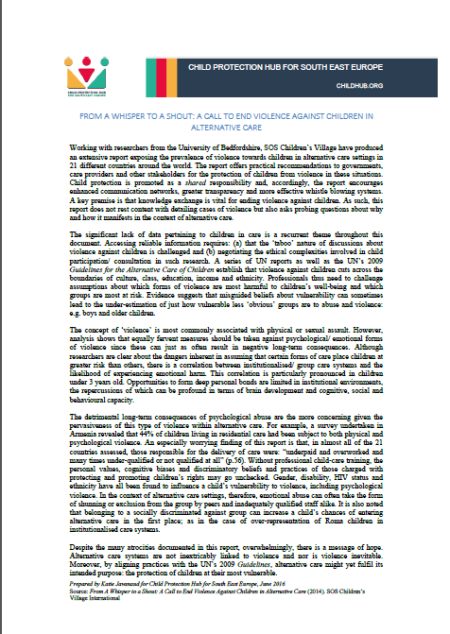- Loghează-te sau înregistrează-te să postezi comentarii
- 93 vizualizări
Working with researchers from the University of Bedfordshire, SOS Children’s Village have produced an extensive report exposing the prevalence of violence towards children in alternative care settings in 21 different countries around the world. The report offers practical recommendations to governments, care providers and other stakeholders for the protection of children from violence in these situations. Child protection is promoted as a shared responsibility and, accordingly, the report encourages enhanced communication networks, greater transparency and more effective whistle blowing systems. A key premise is that knowledge exchange is vital for ending violence against children. As such, this report does not rest content with detailing cases of violence but also asks probing questions about why and how it manifests in the context of alternative care.
The significant lack of data pertaining to children in care is a recurrent theme throughout this document. Accessing reliable information requires: (a) that the ‘taboo’ nature of discussions about violence against children is challenged and (b) negotiating the ethical complexities involved in child participation/ consultation in such research. A series of UN reports as well as the UN’s 2009 Guidelines for the Alternative Care of Children establish that violence against children cuts across the boundaries of culture, class, education, income and ethnicity. Professionals thus need to challenge assumptions about which forms of violence are most harmful to children’s well-being and which groups are most at risk. Evidence suggests that misguided beliefs about vulnerability can sometimes lead to the under-estimation of just how vulnerable less ‘obvious’ groups are to abuse and violence: e.g. boys and older children.
The concept of ‘violence’ is most commonly associated with physical or sexual assault. However, analysis shows that equally fervent measures should be taken against psychological/ emotional forms of violence since these can just as often result in negative long-term consequences. Although researchers are clear about the dangers inherent in assuming that certain forms of care place children at greater risk than others, there is a correlation between institutionalised/ group care systems and the likelihood of experiencing emotional harm. This correlation is particularly pronounced in children under 3 years old. Opportunities to form deep personal bonds are limited in institutional environments, the repercussions of which can be profound in terms of brain development and cognitive, social and behavioural capacity.
The detrimental long-term consequences of psychological abuse are the more concerning given the pervasiveness of this type of violence within alternative care. For example, a survey undertaken in Armenia revealed that 44% of children living in residential care had been subject to both physical and psychological violence. An especially worrying finding of this report is that, in almost all of the 21 countries assessed, those responsible for the delivery of care were: “underpaid and overworked and many times under-qualified or not qualified at all” (p.56). Without professional child-care training, the personal values, cognitive biases and discriminatory beliefs and practices of those charged with protecting and promoting children’s rights may go unchecked. Gender, disability, HIV status and ethnicity have all been found to influence a child’s vulnerability to violence, including psychological violence. In the context of alternative care settings, therefore, emotional abuse can often take the form of shunning or exclusion from the group by peers and inadequately qualified staff alike. It is also noted that belonging to a socially discriminated against group can increase a child’s chances of entering alternative care in the first place; as in the case of over-representation of Roma children in institutionalised care systems.
Despite the many atrocities documented in this report, overwhelmingly, there is a message of hope. Alternative care systems are not inextricably linked to violence and nor is violence inevitable. Moreover, by aligning practices with the UN’s 2009 Guidelines, alternative care might yet fulfil its intended purpose: the protection of children at their most vulnerable.
To read the full report click here






